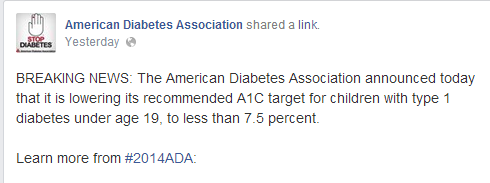Target
This new guideline first crossed my eyes in the form of a **BREAKING NEWS** post on Facebook.
It was posted by the very organization that made the news. (Does anyone else find that just a little bit self-serving and disingenuous?)
But after getting over my disgust over the misrepresentation of (what should have been) a press-release as a groundbreaking, developing situation, my thoughts shifted from the presentation to the message.
And my reaction to the lowering of an A1C target to 7.5% (from something that, I could only guess was something more than that) was a hearty, passionate…
MEH.
So, somebody, somewhere, decided that for kids under 19, lower A1Cs were better A1Cs.
No shit.
Don’t misunderstand me. My apathy towards this news has nothing to do with the fact that I’m more than double the age of the oldest person to whom this applies. It has nothing to do with the fact that it was presented in such a manner. Nor does it have anything to do with the number itself, or which side of the number I spent most (if not all) of my years between diagnosis and my nineteenth birthday.
I simply don’t believe in targets. I believe nothing good can come out of them. Especially non-individualized targets that sweep across a large portion of the diabetes population.
My thought is this: I know that the “normal” non-diabetic A1C is somewhere in the 4’s or 5’s. I also know that being in the 5’s is probably better than being in the 6’s, and being in the 6’s is better than the 8’s, and the 8’s is better than the tens, and the tens are better than the teens… and so on. This, I believe, is irrefutable.
I also know that I have never been in the 5’s since diagnosis, nor do I have any aspirations to get to the 5’s (yes, this is probably my first disclosure of what my A1C is…not.)
What I do know is this: I want my A1C to be as low as I feel comfortable with. (“Comfortable” is a loaded term: a combination of not going to bed in fear of a low and not restricting my diet and lifestyle to the point of “why bother?”)
I will not set a target value, and I will not measure myself against some arbitrary number. I will measure myself against my prior A1C results and make a mental note of what I did differently over the past quarter-year than in the three months prior. Maybe I’ll learn something from that. Maybe I won’t.
But I’ll continue to try to do my best. Day after day, week after week, month after month, quarter after quarter.
And whatever happens … whatever X-point-Y-percent gets reported back to my doctor, I know it’s a reflection on not only how hard I tried, but on what I tried to achieve.
Seven-point-five is an arbitrary and meaningless number:
- To the eight-year-old who’s cruising along at a six-point-seven, it may suggest that he should start choosing chocolate milk with his school lunch rather than white milk.
- To the fourteen-year-old whose A1C hovers around the 14%, it may be devastating. He couldn’t get over the bar before, and now it’s been raised. It’s hopeless and maybe he should just give up.
- To the eighteen-year-old who’s about to move away to college and has no idea what lies ahead, it may be just the push he needs to start organizing his thoughts, his routines, and his life.
Three very different hypothetical scenarios, three very different possible reactions.
But there’s no doubt in my mind that these school-age kids, who are graded on everything they do, see the chances of achieving a passing grade getting a bit slimmer.
WRONG MESSAGE.
Why can’t we just tell these kids (and their parents) that they should just try to do their best, and leave it at that? Whether we’re talking mathematics or weightlifting, nobody expects everyone’s best to be the same. So why should it be when it comes to A1C?
In my mind, that ADA-publicized number…. whatever it is…. is completely meaningless.
Posted on June 18, 2014, in Diabetes, Type 1 and tagged A1C. Bookmark the permalink. 13 Comments.



Totally paranoid, but I keep thinking this is about making it easier for kids to escape negligent parents/easier for the government to intervene & remove children from their homes and shuffle them into foster care. I’m obsessing. I don’t understand who even uses the ADA guidelines. No doctors we know has ever mentioned the number 8. Ever ever never.
I completely agree with you about the wanting to be as close to normal. Won’t some (not me) parents (or old timey pediatricians) going to say chocolate milk is exactly what that kid cruising at 6.7 needs to hit the goal? Ohhhhh. I guess that’s what you mean in scenario #1.
LikeLike
Whether that’s the intent or not, who’s to say it won’t be used for that reason if the opportunity arises? But I suppose moving the bar might put more people into the “uncontrolled” category, which strengthens the argument for more better CGM/test strip coverage by insurance. So it can be used both ways.
LikeLike
I saw one good part on Meri’s post—the ADA backs try-hards up with some “ten strips or more a day may be needed.” That’s nice.
LikeLike
(have)
LikeLike
totally and completely well written beautiful post here.
and accurate. and smart. and just… GREAT!
I know I sure hate having that bar set. For some of us, it’s unattainable no matter how hard we try and results and quarterly sob fests of disappointment for not being good enough.
I think a “range” is better than a set number. and a big range at that.
LikeLike
I guess I’ve been waaaaay out of the loop. I thought that was the target all along, even in my younger years because my doctors always sought for the 7-7.5 range for me.
LikeLike
Amen.
LikeLike
Scott – As a parent of a 14 year old T1D. I have been mulling this information over for the past few days not sure what to even think or say about this. Then I read your post. Thank you, thank you, thank you. I think you have put into words what I could not. Every person with T1D has different circumstances, not even to mention the emotions that go into the concept of getting to an A1C you feel comfortable with. How my son feels when he is low and how he describes it is scary and contributes to how we choose to manage his A1C. Thank you for sharing.
LikeLiked by 1 person
I feel the same way about “targets,” even if they aren’t the immediate focus for an A1C and something to ultimately shoot for. What’s most newsworthy about this ADA statement really isn’t the A1C target, though — it’s that this is the first time the org has EVER made a move with an official position statement distinguishing between the two types. And to really make a point that, just because you’re an adult with diabetes, that doesn’t mean you have Type 2. As to the kid A1C aspect, this puts ADA in line with international guidance and there’s no consistency, rather than A1C having a differing standard and confusing the HCPs.
LikeLike
btw, here’s the actual position statement on T1D Through the Life Span: http://care.diabetesjournals.org/content/early/2014/06/09/dc14-1140.full.pdf+html
LikeLiked by 1 person
Thanks for this, Mike!
LikeLike
The Mike Hoskins ADA link is just what I needed to read. Thanks! It’s like unpacking an explanation of my life.
LikeLiked by 1 person
OK, I love your post and your take on the news. When I first heard the news I thought how unbelievably tough those guidelines must be for younger people. I don’t know what my A1Cs were growing up but in my 20’s I struggled to get below 8. You addressed so many great points in this article. Thanks for sharing.
LikeLike